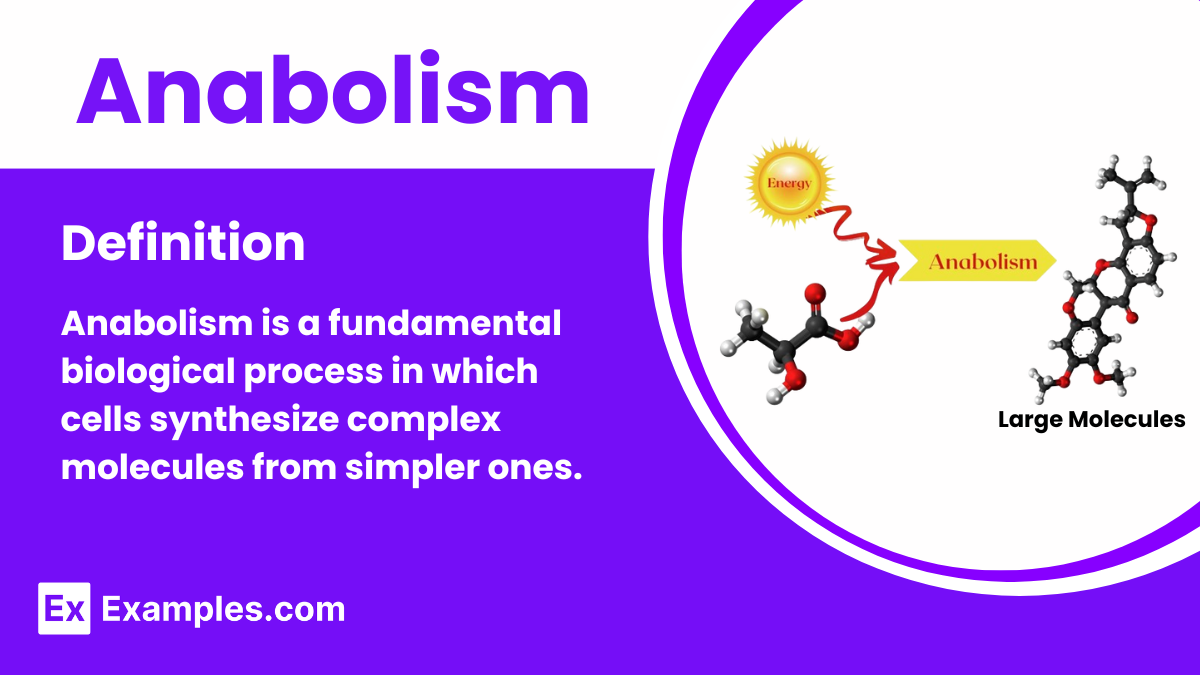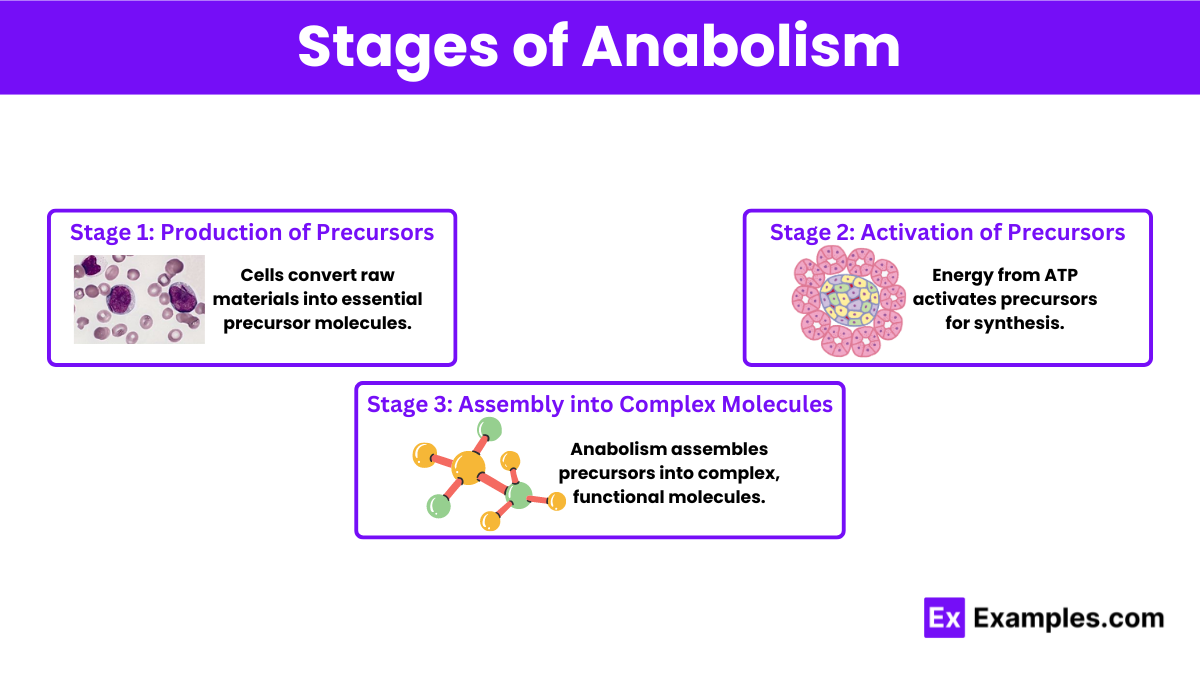Which of the following is an example of an anabolic process?
Glycolysis
Protein synthesis
Cellular respiration
Fermentation

Anabolism is the essential biochemical process that synthesizes complex molecules from simpler ones. Central to growth and repair, anabolism not only builds new cells and tissues but also stores energy, fueling life’s vital functions. Whether you’re a student, teacher, or curious learner, this article will illuminate how organisms construct their living fabric from the molecular level, showcasing the incredible ways our bodies grow, heal, and thrive.
Anabolism is a set of metabolic processes in which cells synthesize complex molecules from simpler ones. These processes require energy, usually derived from ATP (adenosine triphosphate), to build proteins, nucleic acids, and other cellular structures. Anabolism is essential for growth, repair, and cellular maintenance, functioning as the building phase of metabolism that complements catabolism, the breaking down phase.
An example of anabolism is the way your body creates proteins from amino acids. After you eat food containing proteins, your body breaks these proteins down into amino acids. These amino acids then travel to different parts of your body where cells use them to build new proteins. This process helps repair tissues, supports muscle growth, and maintains healthy skin and bones. Essentially, anabolism allows your body to use the building blocks gained from food to sustain and strengthen itself.
Protein synthesis is one of the most crucial anabolic processes. This involves the creation of proteins from amino acids, which are the building blocks of muscles, enzymes, and many hormones. Proteins are essential for repairing tissues, supporting immune functions, and catalyzing biochemical reactions.
Nucleic acid synthesis refers to the formation of DNA and RNA molecules, which are vital for genetic information storage and transfer. This type of anabolism ensures that genetic information is accurately passed from one generation to the next and is crucial for cell division and growth.
Exclusive to plants and certain bacteria, photosynthesis is a process by which light energy is converted into chemical energy. Through photosynthesis, carbon dioxide and water are transformed into glucose and oxygen. This not only fuels plant growth but also provides the basic energy source for nearly all living organisms.
Lipogenesis is the process of synthesizing fats from simpler molecules like carbohydrates and proteins. This type of anabolism occurs in the liver and fat cells, where stored fats are created for energy reserves and insulation, helping organisms manage energy efficiently over longer periods.

In the first stage, cells produce precursor molecules essential for more complex structures. These precursors include amino acids for protein synthesis, monosaccharides for carbohydrate production, isoprenoids for lipid synthesis, and nucleotides for nucleic acid assembly. Enzymes facilitate the conversion of raw materials (from food intake and catabolism) into these basic units.
Once the body forms these precursor molecules, the second stage involves activating them into chemically reactive forms. This activation process uses energy from ATP (adenosine triphosphate). Enzymes play a crucial role here, attaching phosphate groups or other necessary components to the precursors, making them ready for the next step of synthesis.
The final stage of anabolism is the assembly of these activated precursors into complex molecules. This involves the creation of proteins from amino acids, polysaccharides from monosaccharides, lipids from fatty acids and isoprenoids, and nucleic acids from nucleotides. This stage not only involves linking these units together but also folding and modifying them to ensure they function correctly within the cell.
Autotrophs, such as plants, algae, and some bacteria, are self-sufficient in producing complex organic molecules. They use sunlight as their primary energy source through a process known as photosynthesis. During photosynthesis, these organisms convert carbon dioxide and water into glucose and oxygen. This glucose then serves as a key precursor for synthesizing more complex substances like polysaccharides and proteins.
Unlike autotrophs, heterotrophs cannot produce their own food. Instead, they depend on consuming other organisms or organic substances to obtain essential molecules like monosaccharides and amino acids. These nutrients are then used to fuel their anabolic processes, allowing them to build cellular components such as proteins and complex carbohydrates.
Photoautotrophs, similar to typical autotrophs, harness sunlight to drive the synthesis of organic molecules from inorganic substances like water and carbon dioxide. Photoheterotrophs also use light, but unlike photoautotrophs, they require external sources of organic compounds to construct complex organic substances.
Chemoautotrophs obtain energy from inorganic chemical reactions. They oxidize substances like hydrogen sulfide or ammonia to drive the synthesis of organic compounds from simpler inorganic materials. Chemoheterotrophs, on the other hand, gain energy by oxidizing organic compounds. This energy is crucial for their survival and growth as it fuels their anabolic activities to build and repair cellular structures.
Anabolism allows cells to produce new proteins and nucleic acids, essential for tissue growth and cell repair. This function is especially critical during development and healing processes.
This process converts simple molecules into complex ones like proteins, nucleic acids, lipids, and carbohydrates, providing structural components necessary for cells and tissues.
Anabolic processes like lipogenesis store excess nutrients as fats in adipose tissue, which can be mobilized during energy scarcity, ensuring energy availability when needed.
Anabolism helps maintain cellular and physiological balance, regulating blood sugar levels, fluid and electrolyte balance, and hormone production.
Anabolism is vital for synthesizing proteins that form antibodies and immune cells, bolstering the body’s defense against pathogens.
In this process, organic acids convert into monosaccharides like glucose, which further assemble into polysaccharides such as starch. Glucose derives from various sources like pyruvate, lactate, glycerol, and amino acids through gluconeogenesis. While fatty acids stored in adipose tissues cannot directly convert to glucose, plants and bacteria achieve this through the glyoxylate cycle, bypassing the citric acid cycle.
Amino acids, the building blocks of proteins, link together via peptide bonds to form polypeptide chains. Most organisms can synthesize some or all of the 20 common amino acids, with mammals synthesizing only the nonessential ones. The unique sequence of amino acids determines the primary structure of each protein, which undergoes further modifications and folding to attain its final structure.
Nucleotides, crucial for DNA and RNA, are synthesized from amino acids, carbon dioxide, and formic acid, requiring substantial metabolic energy. Purines like adenine and guanine derive from inosine monophosphate, while pyrimidines such as thymine and cytosine originate from orotate, synthesized from various amino acids.
Fatty acids are synthesized from acetyl-CoA units through a series of reactions catalyzed by fatty acid synthases. In animals and fungi, a single multifunctional protein handles these reactions, while in plants and bacteria, separate enzymes perform each step. Other lipids, like terpenes and isoprenoids, are formed by assembling and modifying isoprene units, sourced from reactive precursors.
Anabolism is a fundamental metabolic process that involves the synthesis of complex molecules from simpler ones. This process is essential for growth, repair, and maintenance in living organisms. Here are the key characteristics of anabolism:
Anabolism is the process where the body builds up complex molecules from simpler ones, using energy.
Anabolism involves building up molecules, while catabolism breaks them down, releasing energy.
Metabolism encompasses all chemical reactions in the body, including anabolism which specifically refers to building molecules.
A classic example of an anabolic reaction is the synthesis of proteins from amino acids.
In the human body, anabolism refers to processes that build tissues and organs, using nutrients and energy.
Text prompt
Add Tone
10 Examples of Public speaking
20 Examples of Gas lighting
Which of the following is an example of an anabolic process?
Glycolysis
Protein synthesis
Cellular respiration
Fermentation
Anabolism is most closely associated with:
Energy release
Energy storage
Energy transfer
Energy consumption
Which of the following is NOT an anabolic hormone?
Insulin
Growth hormone
Cortisol
Testosterone
Anabolism is the process of:
Breaking down molecules
Building up molecules
Both breaking down and building up molecules
Neither breaking down nor building up molecules
Which molecule is commonly used to supply the energy for anabolic reactions?
ATP
NADH
FADH2
ADP
Which of the following processes is anabolic?
Digestion of proteins into amino acids
Synthesis of DNA from nucleotides
Glycolysis
Oxidation of fatty acids
The synthesis of which of the following is an anabolic reaction?
Glucose from glycogen
Amino acids from proteins
Fatty acids from triglycerides
Glycogen from glucose
Which vitamin is crucial for many anabolic reactions due to its role as a coenzyme?
Vitamin A
Vitamin C
Vitamin B12
Vitamin D
Anabolic processes are typically:
Exergonic
Endergonic
Thermodynamically neutral
Independent of energy changes
Which of the following best describes anabolism?
Energy-releasing reactions
Both energy-releasing and energy-storing reactions
Neither energy-releasing nor energy-storing reactions
Energy-storing reactions
Before you leave, take our quick quiz to enhance your learning!

